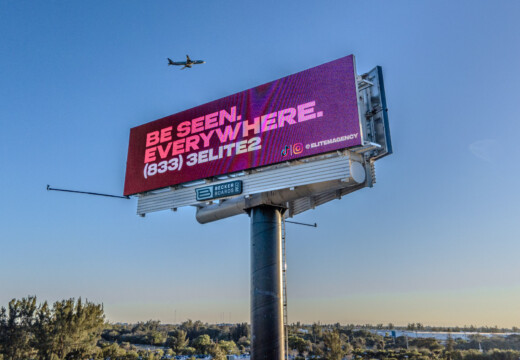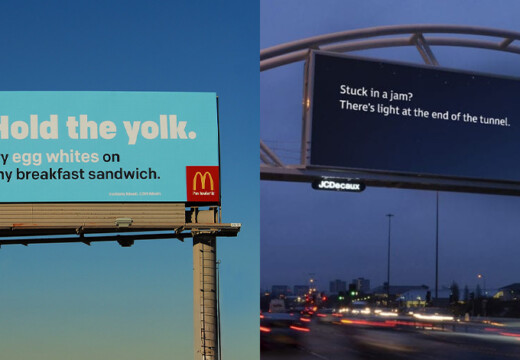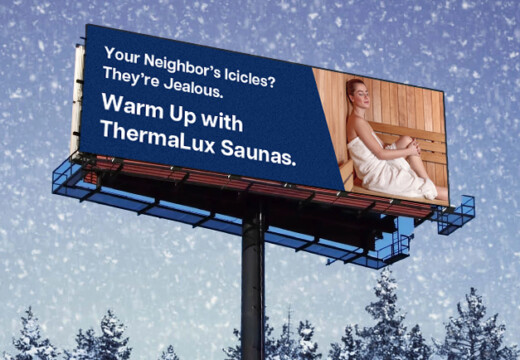Your audience isn’t just online – they’re at bus stops, driving to work, grabbing lunch, and walking through busy shopping districts. Out-of-home (OOH) advertising puts your message right in front of them when they’re actually paying attention. But with so many formats available, how do you know which one will work best for your brand?
From massive digital billboards to targeted transit ads, the different types of OOH advertising each offer their own strengths. And if you’re looking for digital out-of-home (DOOH) specifically, Blip is leading the charge. With nationwide reach, flexible scheduling, and zero contracts, Blip makes DOOH affordable and accessible, even if you’re working with a small budget.
If you’re ready to move beyond expensive media buys and start placing your brand in high-traffic areas without the hassle, this guide will walk you through the major types of OOH advertising – and help you figure out which one fits your goals.
Key Takeaways
- OOH advertising includes multiple formats like billboards, transit ads, street furniture, DOOH, and place-based networks.
- Digital billboards through Blip allow small businesses to advertise with no contracts, no production costs, and full control over when campaigns run.
- Transit ads on buses, subways, and in airports deliver broad exposure and are ideal for community-focused or luxury brands.
- Street furniture ads like bus shelters and kiosks reach pedestrians at eye level and now include digital, interactive elements.
- Place-based media networks target audiences in retail, fitness, or entertainment venues where dwell time is high.
- Modern tools like mobile attribution and Blip’s analytics dashboard allow advertisers to track impressions, foot traffic, and sales lift.
- Blip’s self-serve platform makes it easy to test, scale, and optimize OOH campaigns without a big budget or marketing team.
What Is OOH Advertising?
Out-of-home (OOH) advertising refers to any type of promotion that reaches people in public spaces – places where your customers already spend time during commutes, errands, or leisure activities. These ads are unskippable, unblockable, and consistently visible, which gives them a distinct edge over traditional digital formats.
The impact of OOH advertising comes from repeated real-world exposure. Your message becomes a familiar fixture in the local environment, reinforcing brand recognition day after day. And while traditional billboards remain a staple, modern OOH now includes digital formats that adjust based on time, weather, or audience behavior.
OOH fits both local and national campaigns. A neighborhood café can target drivers during morning rush hour, while a multi-location brand can launch synchronized regional campaigns across multiple cities. Blip Billboards makes this accessible with contract-free campaigns that give any business the power to go public with its message on its own terms.
Types of OOH Advertising
Out-of-home advertising includes a wide range of formats, each designed to reach people in specific public spaces. From towering billboards to smart city kiosks, the right format depends on your goals, audience, and budget. Below are the main types of OOH advertising and how each one can help your business connect with real-world customers.
Traditional Billboard Advertising
Billboards are the most iconic form of OOH advertising. Strategically placed along highways and high-traffic urban corridors, they deliver high-volume impressions every day.
What used to be reserved for major brands is now accessible to small businesses through platforms like Blip.
Today’s digital billboards offer flexibility that static formats cannot match. You can change your ad instantly based on time of day, weather, or local events. A breakfast promo can run during morning rush hour, then switch to dinner specials in the evening.
Blip’s platform allows businesses to upload designs, set a budget, and start running ads without contracts or production costs. Campaigns can begin at just a few dollars per day, allowing even small local businesses to compete for attention.
To get the most from billboards, target high-traffic locations that match your audience. Analyze commuting routes, retail zones, and weekend traffic patterns. Keep creative simple and bold with one call-to-action. Use contrasting colors and test multiple messages to see what resonates.
Experiment, optimize, and scale your outdoor ads without wasting a dollar – try Blip today.
Transit Advertising
Transit advertising turns public transportation into mobile media. Buses, subways, trains, and airports all offer unique opportunities to connect with people during their daily movement.
Bus advertising offers several formats:
- Full wraps covering the entire vehicle
- King-size panels on the sides
- Tail panels visible to following drivers
- Interior cards for seated passengers
These ads travel through multiple neighborhoods daily, creating repeated exposure among varied demographics. Local routes often pass near schools, shopping centers, and business parks, making them ideal for community-focused businesses.
Subways and rail systems offer long exposure times. Posters on platforms and inside train cars reach riders during extended commutes. Digital screens can rotate messages or sync with train arrivals for higher visibility.
Airport advertising targets high-income, travel-savvy consumers. Long wait times in terminals lead to stronger ad recall. This format works well for luxury brands, financial services, and travel-related promotions.
Street Furniture Advertising
Street furniture refers to ad displays built into urban structures, meeting people at eye level as they walk, wait, or rest. These include bus shelters, kiosks, and benches.
Bus shelter ads are highly visible and weather-protected. Their placement in busy pedestrian areas makes them ideal for call-to-action campaigns. Digital versions include motion, touch interactivity, and location-based content.
Urban panels and kiosks are located near crosswalks, entrances, and transit stops. These spots are ideal for directional messaging that guides foot traffic to nearby stores or services.
Smart city advancements have added functionality.
Displays now offer free Wi-Fi, mobile charging, and city maps, which increases dwell time and engagement with surrounding ads.
Digital Out-of-Home (DOOH) Advertising
DOOH represents the most dynamic and measurable format within OOH advertising. It allows advertisers to update messages in real time and adjust based on data like time of day, weather, or foot traffic.
Use cases include:
- Coffee shops promoting hot drinks on cold mornings
- Outdoor gear stores running ads only on sunny weekends
- Restaurants adjusting their menu promotions throughout the day
Platforms like Blip put programmatic DOOH in reach for any business. You can launch campaigns with minimal spend, select exact locations and times, and track performance by impression or CPM.
What makes DOOH powerful is its accountability. Track impressions using traffic data, monitor engagement through QR codes, and connect exposure to actual store visits or digital actions.
Launch your first digital billboard campaign today with Blip and enjoy full flexibility with no contracts or commitments.
Place-Based Media Networks
Place-based advertising targets people in venues where they spend longer periods of time, making it ideal for more detailed or contextual messaging.
Retail environments offer multiple ad touchpoints. Malls, grocery stores, and big-box chains use display screens, floor decals, and aisle signage to influence purchase behavior. With average shopping times reaching 41 minutes, these placements offer deep engagement near the point of sale.
Entertainment venues like cinemas, stadiums, and concert halls provide immersive brand exposure. Moviegoers are highly attentive before the show, while fans at sports events are emotionally engaged, making your message more memorable.
Healthcare and fitness centers provide regular, extended exposure. Waiting room screens inform and advertise to patients. Pharmacy displays influence purchase decisions at the checkout counter. Gyms offer repeated impressions to motivated, health-conscious individuals several times a week.
Choosing the Right OOH Mix for Your Business
An effective out-of-home strategy begins by aligning format choices with your business goals, audience behavior, and available budget. The most successful advertisers don’t rely on a single format – they build layered campaigns that meet customers where they are throughout the day.
Before selecting your mix, consider the following key strategies:
Map Customer Patterns
Identify where your audience spends their time. B2B companies should prioritize highways and business corridors during morning and evening commutes. Retailers and service-based businesses benefit from targeting shopping centers, suburban intersections, and transit-heavy zones where foot traffic is consistent.
Start Small, Scale Smart
Begin with digital billboards using Blip’s self-serve platform. This lets you test different messages, locations, and times without long-term contracts or large upfront costs. Once you identify what works, expand into other formats such as transit ads or bus shelter placements to reinforce your brand message.
Budget by Objective
Large-format billboards on busy roadways are ideal for awareness campaigns. Street furniture and place-based ads work best for local promotions or foot traffic. Digital formats give you the agility needed for event-driven advertising. Rather than spreading your spend across all channels, focus it where results are measurable and aligned with specific outcomes.
Integrate Across Channels
Bridge your OOH and digital efforts by using trackable QR codes, short URLs, or custom promo codes. Launch outdoor campaigns alongside email sends or paid social pushes for consistent messaging across all touchpoints. This cross-channel approach helps increase engagement while making campaign performance easier to track.
Create bold billboard ads and go live in minutes using Blip’s self-serve platform.
Measuring Success and ROI
Modern out-of-home advertising provides measurable data that goes far beyond guesswork. With today’s tools, you can track performance, optimize campaigns in real time, and confidently link your spend to business results.
Below are the main ways to measure campaign effectiveness and return on investment.
Impression and Engagement Metrics
Impressions serve as the foundation for OOH measurement, but surface-level exposure isn’t the full picture. To assess real impact, track website traffic spikes during campaign periods, foot traffic near ad locations, and redemptions of custom promo codes or QR links.
That said, impressions are still one of the most important metrics to pay attention to, and Blip Billboards provides you with these figures in a user-friendly dashboard, so you know how many people viewed your advertisements in a given time period.
Blip allows you to view the number of impressions for individual billboards and or aggregate across your campaign.
Mobile Attribution and Customer Behavior
Mobile location tracking provides clear attribution by showing how many people exposed to your ad later visit your store. These insights help you understand how outdoor impressions fit into the broader customer path – from awareness to action. Use this data to fine-tune not just ad placement, but creative strategy and timing as well.
Sales Lift and ROI Analysis
Sales lift studies offer clear evidence of performance. By comparing markets with active OOH campaigns to control markets without, you can measure the direct impact on revenue, conversions, or in-store visits. When executed properly, these studies often show a tangible return, validating your spend and guiding future media investment.
Getting Started With OOH Advertising
You don’t need a massive budget or a marketing team to launch a successful out-of-home campaign. Thanks to modern self-serve platforms like Blip, OOH is now accessible to businesses of all sizes, with real-time control and measurable results.
Before selecting formats, define what your campaign is meant to accomplish. The right choice depends on your objective, so it’s important to align format with intent. Below are key steps to help guide your first campaign.
Match Format to Goal
Brand awareness efforts often perform best on large-format billboards placed along high-traffic routes. These placements offer maximum visibility and repeated exposure.
If your goal is to drive in-store traffic, focus on local placements like bus shelters or urban panels near your business. For limited-time offers or event-based promotions, use digital formats that allow real-time updates and precise scheduling.
Design for Visibility and Impact
Designing effective OOH creative means keeping it simple and bold. Use minimal text, no more than six words on highway-facing formats, and make sure fonts are legible at a distance. Stick to high-contrast color schemes that stand out in bright conditions.
Always include one clear call-to-action that tells people what to do next, whether it’s visiting a location, scanning a QR code, or remembering your brand name.
Test, Learn, and Scale
Start with a modest daily budget to test different ad creatives, locations, and time slots. Blip gives you the flexibility to experiment freely without long-term commitments.
Use the performance data to identify what’s working and refine your strategy. Expand on what delivers results, cut what doesn’t, and gradually build a campaign that maximizes return without wasting spend.
Transform Your Marketing With Modern OOH Advertising
Out-of-home advertising is no longer limited to static billboards and high-budget campaigns. With formats like transit ads, street furniture, DOOH, and place-based media, businesses of all sizes can reach consumers in real time across high-traffic locations.
The key to success is aligning format with objective, targeting the right environments, and using performance data to refine campaigns.
Ready to put your brand in front of thousands of potential customers every day? Start your OOH campaign with Blip Billboards. Our self-service platform makes launching professional outdoor campaigns as easy as running Facebook ads – but with the credibility and impact only physical advertising delivers.
Get started with Blip today! Your first campaign can be live in minutes.
Frequently Asked Questions
What’s the Difference Between DOOH and Traditional OOH Advertising?
Traditional OOH includes static billboards and physical signage, while DOOH uses digital screens that update in real time. DOOH allows for flexible scheduling, dynamic content, and real-time performance tracking, making it more adaptable and measurable than static formats.
Are OOH Ads Effective for Driving In-Store Visits?
Yes, OOH ads can significantly increase foot traffic, especially when placed near retail locations. Mobile location tracking and customer behavior data help link ad exposure to physical visits, giving you clear insight into campaign performance and return on investment.
Can I Target Specific Neighborhoods or Demographics with OOH?
Absolutely. Platforms like Blip let you choose exact billboard locations and dayparts. You can align ads with commuting routes, shopping centers, or event venues to target specific audiences. For deeper targeting, transit and place-based ads can also be strategically placed.
What Type of OOH Works Best for Short-Term Promotions?
Digital billboards and other DOOH formats are ideal for short-term or event-driven campaigns. You can schedule ads for specific times or days, update creative instantly, and pause or shift spend based on performance – all without long-term commitments.
How Do I Track the ROI of My OOH Campaign?
Use tools like QR codes, promo codes, and URL tracking to connect ad impressions to digital or in-store actions. Blip’s dashboard shows real-time impressions and helps you track performance by location and time. Sales lift studies can validate ROI by comparing active markets to control groups.


